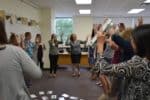
I was thrilled to read a January 9, 2020, blog post, “The Impact of Singapore Math at MPA,” written by Lower School Director Renee Wright. It is a brief, but thorough, overview that anyone considering a Singapore program should read.
Renee recounts some of the many reasons the school chose to adopt a Singapore program in kindergarten through fifth grade six years ago, including:
Singapore Math meets the needs of all learners, provides extra practice and support for students when necessary, and is inherently challenging for the advanced math student.
To illustrate her point, Renee invites readers to consider a word problem assigned to fourth graders:
Mrs. Wright, Dr. Hudson, and Ms. Tesdahl all wrapped lots of presents over the holidays. Mrs. Wright wrapped four times as many as Dr. Hudson (remember, she has grandchildren!), and Ms. Tesdahl wrapped 3 more than half as many as Mrs. Wright. Together they wrapped 31 presents. How many presents did Dr. Hudson wrap?
She notes that this is a challenging problem for Lower School students and maybe even readers. But:
Believe it or not, fourth-graders at Mounds Park Academy approached this problem with confidence and were successful in finding the solution.
Renee includes data to document student success:
We can carefully examine the longitudinal data and impact of Singapore Math. One way is to review ACT Aspire assessment data collected over the past several years to determine if our students’ scores have shown improvement. Our student data has been compared to national percentiles and independent school benchmarks and it shows that our students have made steady gains in math concepts and usage.
She also includes anecdotal evidence from several teachers, including: Renette Stinson and Shelley Steingraeber (third grade); Deedee Stacy and Yamini Kimmerle (fourth grade); and Chris Peterson (fifth grade). Deedee and Yamini said:
Singapore Math is designed to give students an extremely well developed mathematical foundation, and to challenge them daily to apply mathematical concepts in new situations. Our students at MPA love to learn, and Singapore Math makes that happen!
And what did students say?
…third graders [said] that Singapore Math is challenging, but fun! One student identified the mental math emphasis as something that helps him use math every single day. Another student said she used to hate math but now she loves it because Singapore Math makes sense.
Finally, Renee offers her reflections:
Today, as an administrator looking at the data, hearing from the teachers, and feeling the enthusiasm for math from our students, I know that adopting Singapore Math was the right decision. It has served our students well and is aligned with the college preparatory nature and foundational mission of our school. I am so proud of the time, attention, and effort our teachers have put into teaching the Singapore curriculum. I acknowledge and celebrate the math success our students have had daily in the classroom due to the Singapore Math curriculum and feel confident they are ready for their future journey of higher level math.



































